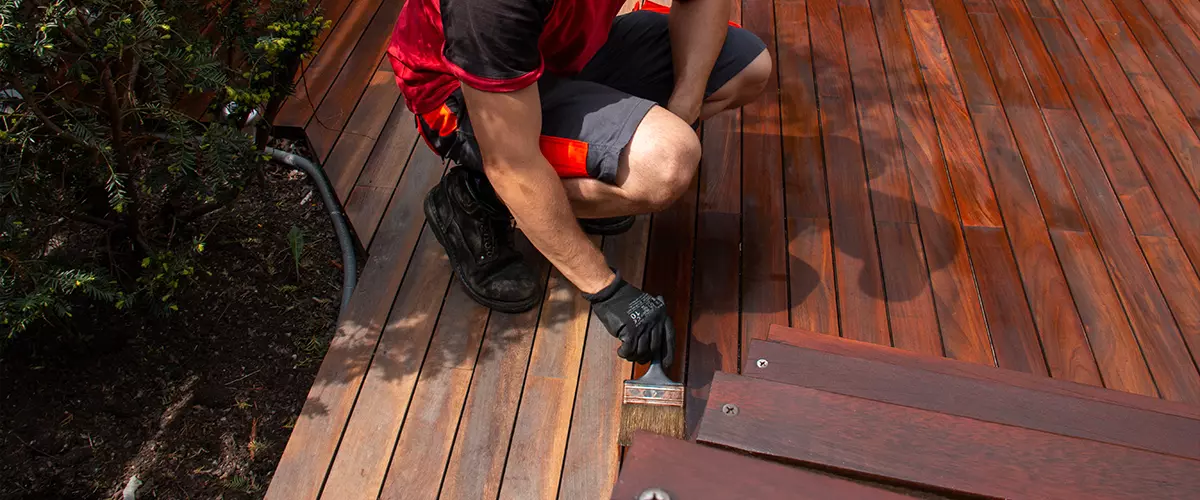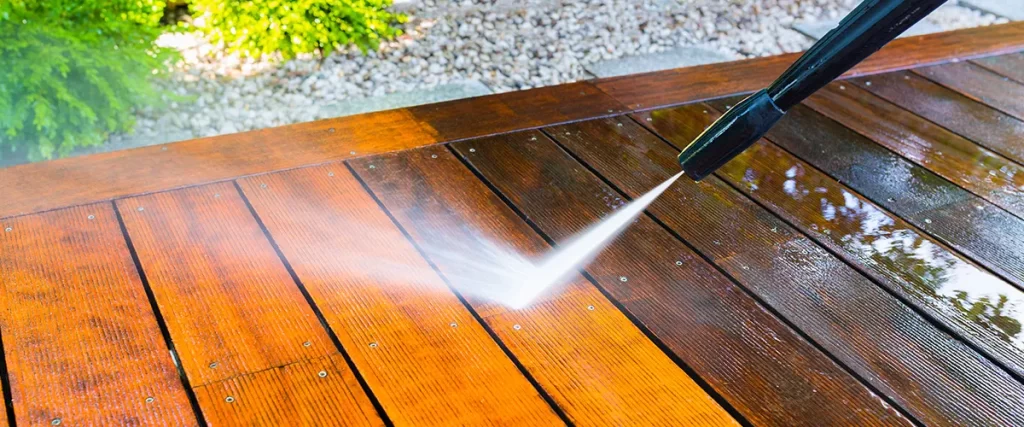Ever felt like your deck needs a little extra TLC? Well, you’re not alone. Maintaining your deck doesn’t have to be a head-scratcher. Think of it as giving your outdoor area a bit of a spa day – minus the cucumber eye masks.
Today, we’re going to give you the best tips for deck maintenance, breaking them down into simple, actionable tips. No need for a superhero cape; just grab your regular tools, and get ready to elevate your deck game. Trust us; your deck will thank you with years of steadfast service. Let’s get started!

Safety Is The Number One Priority
Before diving into the hands-on part of deck maintenance, let’s talk safety. First and foremost, equip yourself with the essentials: sturdy gloves to shield your hands, safety goggles to keep those peepers safe from debris, and a trusty mask to filter out any dust particles.
If your maintenance involves cleaning solutions or sealants, make sure your workspace is well-ventilated. Also, don’t forget to wear non-slip shoes – a simple yet crucial step to prevent accidental slips and tumbles.
Lastly, check the weather forecast; you don’t want unexpected rain or scorching sun throwing a curveball into your maintenance plans. Remember, the goal here is not just a polished deck but a safe and sound maintenance session. Suit up, and let the maintenance begin!

Why Deck Maintenance Is About Protecting Your Expense
Your deck, often the unsung hero of outdoor spaces, silently withstands the elements, supporting countless gatherings, family barbecues, and moments of quiet contemplation. Yet, it’s easy to overlook its resilience and forget that even the sturdiest structures need a bit of care. Here’s the real talk – deck maintenance isn’t just about vanity; it’s a vital step in ensuring your outdoor retreat stands the test of time.
You and your family’s safety is the number one reason for doing regular deck maintenance. You don’t want to end up in a situation where you’re hosting a barbeque and suddenly the mood shifts abruptly because of a wobbly railing or a loose board.
Ensuring the safety of your loved ones is the paramount reason why deck maintenance matters. Regular check-ups catch potential hazards early, allowing you to address issues before they become safety concerns.
Maintenance helps your deck last longer, and that’s a fact. Just like a fine wine, your deck can age gracefully – but only with a little care. Regular maintenance prevents common issues like rotting, warping, or the gradual decay of materials. By investing a bit of time and effort, you’re essentially extending your deck’s lifespan, ensuring it remains a steadfast companion through seasons of sun, rain, and everything in between.
You’ll have the best-looking deck on the block! While we’re not big fans of keeping up with the Joneses, we feel like it’s normal to want your deck to look good! After all, you invested so much money into it, so it makes sense to want to keep it good-looking.

Deck Inspection 101
Now that we’ve got our safety gear on, let’s start with inspecting your deck. This is the phase where you channel your inner Sherlock and look for clues, or in our case, potential issues that could turn into major headaches down the road.
1. The Sherlock Stroll: Visually Checking Your Deck
2. The Tap Test: Sounding Out Trouble
3. Checking the Fasteners & Connectors
4. Look Out For Water Damage
5. Thoroughly Look Out For Mold
6. The Boardwalk Check: Assessing Deck Boards

Cleaning Your Deck: Easy DIY Solutions
Gentle Soap and Warm Water: The Dynamic Duo
Vinegar For Mild Stains
Pressure Washer Power: Use with Caution
Baking Soda For Tougher Stains
Rinse and Repeat: Thoroughly Wash Away

Protecting Your Deck From The Elements - Waterproofing Basics
1. Choose the Right Sealant: Your Deck's Best Friend
The first line of defense in waterproofing your deck is a quality sealant. Choose a sealant specifically designed for your deck’s material – whether it’s wood, composite, or another type. The sealant forms a protective barrier, preventing water from seeping into the pores of the wood or causing damage to other materials.
2. Clear the Deck: A Blank Canvas for Waterproofing
3. Application Magic: How to Seal the Deal
4. Regular Reapplication Is Crucial
5. Address Repairs Promptly: Patching Up Leaks
Even with the best sealant, wear and tear can occur. Promptly address any issues like peeling or damaged sealant to prevent water infiltration. Regular inspections allow you to catch these issues early, ensuring your deck remains watertight.
By mastering the basics of deck waterproofing, you’re not just shielding your deck
from the elements – you’re investing in its longevity and preserving its aesthetic charm.

Replacing Damaged Boards - Step By Step Guide
Word of warning! Replacing boards can be complicated if you’re not sure what you’re doing and can even result in injury. If you are on the fence about doing this, it’s best to leave it for the professionals. Feel free to contact us at (402) 369-5724 for any deck needs.
Even with regular maintenance, wear and tear can leave its mark on your deck. Fear not – board replacement is your ace in the sleeve, offering a swift and effective solution to keep your deck in top-notch condition. Let’s delve into the steps of board replacement:
1. Spotting the Culprits: Identifying Damaged Boards
2. Deck Surgery: Safely Removing Old Boards
3. Choosing The Right Board Size
4. The Perfect Match: Selecting Replacement Boards
5. Secure and Seal: Attaching the New Board

Consistency is Key
If you follow this routine and use the tips we talked about in this blog post, we can almost guarantee that your deck will look and perform much better in time. If you can prevent an issue, it’s going to save you a lot of time and money down the line.
If you require assistance with maintenance or any other deck-related task like deck building, installing, or repairing, feel free to reach out to us at Deck Bros: (402) 369-5724.
